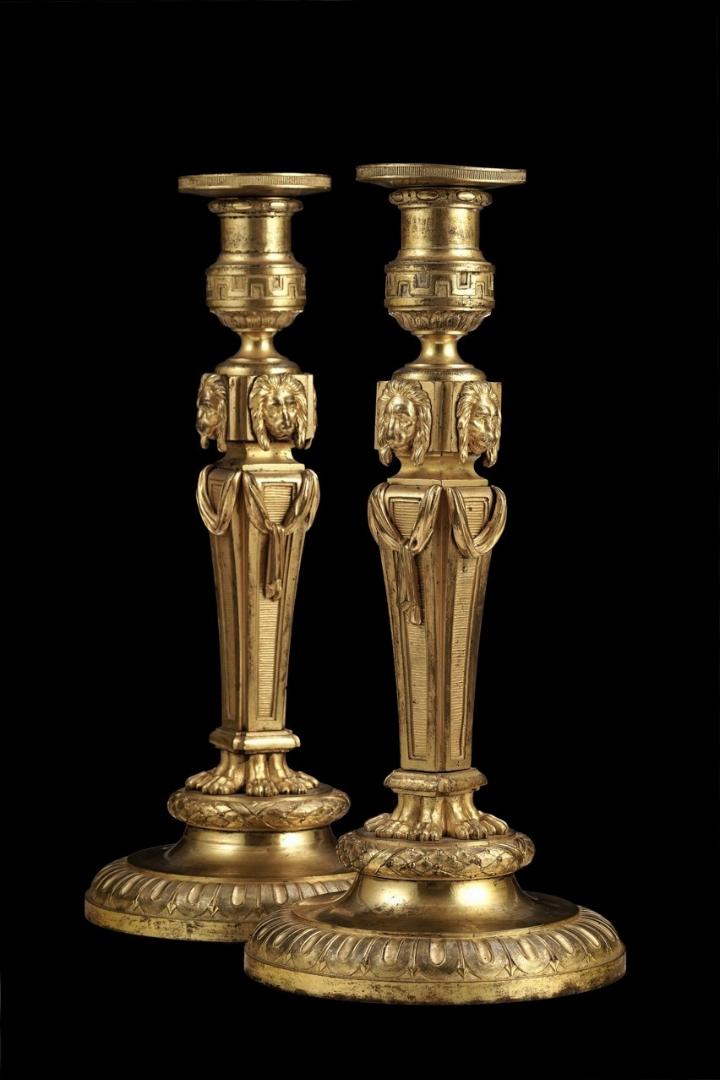A Timeless Masterpiece: Pierre Gouthière’s Louis XV Candlesticks at Piguet’s December Auction in Geneva
26.11.2025 Arts & CultureOne of the most coveted pieces of French gilt-bronze artistry comes to auction in December: an exceptional pair of Louis XV period candlesticks attributed to the renowned French bronze chaser Pierre Gouthière. These finely chased and mercury-gilt bronze candlesticks, standing at 35 cm in height, are a remarkable example of the neoclassical style that emerged during the late 18th century. Drawing from the classical ideals of symmetry, order, and architectural balance, these candlesticks epitomise the elegance and refinement that defined the finest works of the Louis XV period.
Attribution to Pierre Gouthière, a leading figure in French bronze work, places these candlesticks among the most prestigious and highly sought-after objects in the world of decorative arts. Gouthière’s extraordinary skill in chasing and gilding was highly regarded during his lifetime, and his works continue to be celebrated for their unmatched artistry and precision. The candlesticks on offer at Piguet’s December auction are an exemplary showcase of his mastery and of the luxurious taste of the French aristocracy in the 18th century.
An icon of Neoclassicism
The design of these candlesticks is a brilliant reflection of the neoclassical style that dominated France in the 1760s and 1770s, known for its restrained elegance and its return to the classical motifs of Ancient Greece and Rome. This style, often referred to as the “Greek” taste, was a deliberate response to the exuberance of the Rocaille style that had preceded it. It was a moment when the French aristocracy, influenced by the rediscovery of Pompeii and Herculaneum, began to embrace more structured and symmetrical forms, with a preference for clean lines and classical ornamentation.
The candlesticks’ central shaft is adorned with four lion masks, a recurring motif in Gouthière’s work, and is draped with finely chased fabric that adds a touch of luxurious texture. Resting on conjoined lion paws, the shaft is elegantly crowned by a nozzle decorated with a Greek-key motif that emerges from a bouquet of lotus leaves. This Greek-key design, which also appears in the frieze encircling the pedestal base, underscores the neoclassical inspiration behind the piece. The laurel-rod ornamentation and dart-and-egg friezes on the base further exemplify the classical influences that were so highly prized during the period.
The careful attention to symmetry and balance in the design of these candlesticks is a hallmark of the neoclassical style. Every element of the design, from the placement of the lion masks to the intricate detailing of the friezes, bespeaks a sense of architectural harmony. The candlesticks are not merely functional objects; they are works of art that reflect the refinement and taste of aristocracy and nobility.
Gouthière’s mastery of gilding and chasing
One of the most striking aspects of these candlesticks is their exquisite gilding, which has been meticulously executed using the technique of mercury gilding. This method, which was a recent innovation during the Louis XV period, involved applying a thin layer of gold to the surface of the bronze using a mercury-based process. The result is a brilliant, lustrous finish that imbues the objects with a depth and richness of tone that is truly exceptional.
The interplay between matte and burnished surfaces on these candlesticks enhances their visual impact. The matte gilding, in particular, creates a contrast with the more polished areas, bringing out the intricate chasing and revealing the exceptional skill of the artist. The lion masks, draperies, and clawed feet are brought to life through the dense and spirited chasing that is characteristic of Gouthière’s work. This technique allows the metal to retain a sense of tactile richness, further enhancing the object’s allure.
The exceptional quality of the gilding and chasing on these candlesticks places them among the finest examples of 18th-century French bronze work. Gouthière’s ability to transform bronze into an almost living, breathing material, capable of reflecting light and shadow with remarkable depth, is one of the reasons his works are so highly revered.
A perfect echo of François-Thomas Germain’s influence
It is not only Gouthière’s extraordinary technical skills that make these candlesticks a masterpiece but also the influence of his early collaborations with the renowned silversmith François-Thomas Germain. Gouthière worked alongside Germain in the early years of his career, and several analogies can be drawn between their works. For example, the tapered supports adorned with heads and animal paws on the base of Germain’s 1762–1763 kettle brazier (now housed at the Museum of Ancient Art in Lisbon) echo the design of the four shafts and lion masks on the candlesticks. This connection to Germain, another towering figure in the world of 18th-century French decorative arts, further elevates the candlesticks' historical significance and highlights the collaborative nature of artistic creation during this period.
Provenance: A legacy of connoisseurship
The provenance of these candlesticks adds to their appeal. They once belonged to the esteemed Geneva collection of Xavier and Léon Givaudan, two industrial pioneers who amassed an extraordinary collection of French 18th-century art during the early 20th century. The Givaudan brothers, renowned for their success in the perfume industry, were also passionate collectors with a deep appreciation for the artistry of the French Rococo and Neoclassical periods.
Their collection, which was carefully curated through the guidance of leading art dealers, included some of the finest examples of French decorative arts. Xavier Givaudan’s contributions to the cultural and philanthropic life of Geneva were widely recognised, and his legacy continues to be celebrated today. The candlesticks are accompanied by a detailed provenance, including a 1939 invoice from Parisian dealer Paul Selz, further confirming their prestigious lineage.
A rare opportunity
This December auction at Piguet provides an unparalleled chance to acquire a piece that is not only a testament to the genius of Pierre Gouthière but also a symbol of the opulence and grandeur of the French aristocracy in the late 18th century. As the auction date approaches, anticipation is sure to build around these magnificent candlesticks, which stand as a timeless tribute to one of the most celebrated periods in the history of French decorative arts.
by Alan Ipekian
Auction in Geneva
27 November to 11 December 2025
Auction Catalogue
ORDER BY POST
Telephone 022 320 11 77
ONLINE
piguet.com
Auction Preview in Geneva
12noon to 6pm
Friday 5, Saturday 6, and Sunday 7 December
Rue Prévost-Martin 51, Geneva





